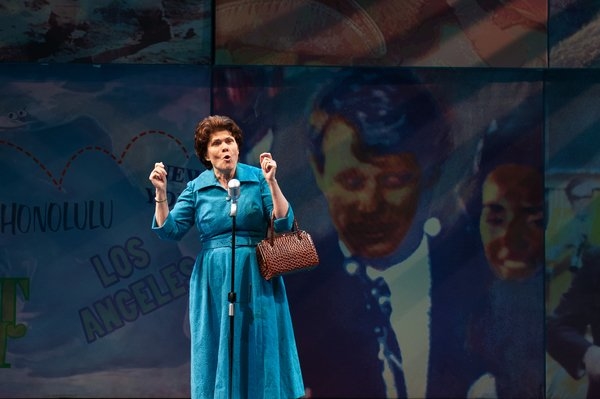
(© Margot Schulman)
Signature Theatre is producing the world premiere of a spirited, lighthearted musical comedy, Mrs. Miller Does Her Thing. Written and directed by Pulitzer Prize winner James Lapine (Sunday in the Park With George, Into the Woods), the play is based on the real-life story of Elva Miller, a middle-aged California housewife who became famous in the 1960s for singing off-key, wobbly versions of popular musical hits.
Lapine's play begins in 1966 in a senior living home where Mrs. Miller's husband, John, is recovering from a stroke. Apart from visiting him, her life primarily consists of singing in the Presbyterian Church choir, with a "voice that never blended." But according to the improbabilities of Lapine's script, Mrs. Miller began recording a few popular songs (like "Cherish") with a trio of young singers. A producer heard the recordings, found them screamingly funny, and Mrs. Miller was roped into a huge joke that changed her life.
Slowly, Mrs. Miller's connection to Capitol Records grew bigger and bigger as she had increasing success. She appeared on the Ed Sullivan show and was invited by Bob Hope to come to Vietnam to visit the troops. She sang Beatles hits ("A Hard Day's Night," "She Loves You," "I Want to Hold Your Hand"), "Monday, Monday," "The Girl From Ipanema," and "Downtown," howling her version of the tunes along with the background singers, who sing on key.
But every once in a while – just for a moment — Mrs. Miller's singing is perfect. Her pitch is clear as a bell and one wonders what she really heard as she sang. In fact, at one point, she says, "All I hear is the beauty in the music." Mrs. Miller is the story of a woman who can't be spoiled. She becomes phenomenally wealthy, but it doesn't change her down-home spirit. Even though the conditions of her life alter by the end of the show, her old-fashioned attitude toward honesty and trust don't change one iota.
Debra Monk is marvelous as an expansive Mrs. Miller, who seems to be kind and thoughtful to everyone, like a doting aunt. She is tremendously supportive of her niece, Joelle, and introduces her to a young man, Simon, who eventually becomes her boyfriend. It is clear from the two occasions that Monk sings without the warble that she in fact has a lovely, strong voice.
Boyd Gaines is fine as Mr. Miller, who was once a strong, sexy gentleman who loved to dance with his wife. Now confined to a wheelchair, Gaines creates a strong sense of Mr. Miller's anger and frustration. All he wants to do is go home. Instead, he is forced to stay in the nursing home and visibly turn into an increasingly fragile shell of a human being.
Will LeBow who plays Mr. Miller's doctor (and Ed Sullivan among several other roles) is excellent. Rebekah Brockman is delightful as Joelle. She helps her aunt early in her career, but by the time Mrs. Miller goes to Vietnam, Joelle's moral objection to the war gets the better of her and she refuses to go. Brockman makes it clear that Joelle grows from a college freshman whose greatest dream is to get into a sorority, and becomes a young woman with real political choices.
Corey Match, who portrays Joelle's boyfriend Simon, is particularly moving as he is forced to face his own fear when he is drafted into the Army. The three backup singers who accompany Mrs. Miller provide a much-needed boost of humor and energy. Jacob ben Widmar plays a choreographer and dancer. Kimberly Marable and Kaitlyn Davidson play two high-stepping go-go dancers who – through the choreography of Josh Prince – have an opportunity to show off every important dance step ever invented in the 1960s.
Lapine directs his play-with-music almost as if it is a cartoon. Considering the outrageousness of the subject and the far-fetched scenes, the style feels fitting. Heidi Ettinger's set includes a scrim at the rear of the stage on which photos from the 1960s have been superimposed — a picture of the moon landing, a photo of Robert Kennedy, a newspaper headlining Martin Luther King's assassination. The action takes place before this curtain, with a few set pieces suggesting place, such as the nursing home, Mrs. Miller's home, Vietnam, and so on. Costume designer Jennifer Caprio uses an increasingly wild palette as the '60s decade progresses, with the dancers wearing shorter skirts and more vibrant colors. In 1969 even Mrs. Miller wears a muumuu of neon paisley fabric. The music direction, by Matt Hinkley, is sharp and snappy, with the four-person band hidden on a side balcony above the stage.
Mrs. Miller Does Her Thing doesn't pretend to be a comment on the political changes taking place in America in the 1960s or the contrasts between older people and the younger generation. It is content to tell a very funny tale about what many people felt was a joke on an older woman. But by the end of the play, it's clear that Mrs. Miller had the upper hand all along.









